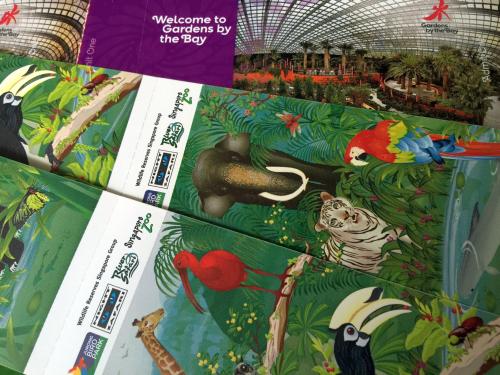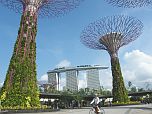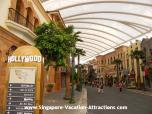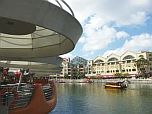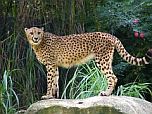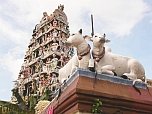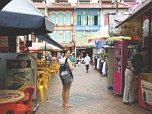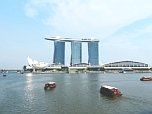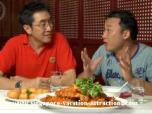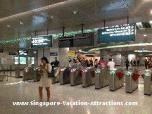Traditional Festivals in Singapore
The three most important festivals celebrated in Singapore are Chinese New Year, Hindu festival Thaipusam and Malay festival Hari Raya Puasa.
Locals celebrate traditional festivals in Singapore throughout the year. Singapore's rich heritage is a mixture of cultures, each with its own unique set of beliefs, values and traditions.
While it is known to be a cosmopolitan state, majority of the nation's population fall into the three primary ethnic groups - Chinese, Malay and Indian. From beginning to end of the year, you will find various corners of the city dressed up with bright and colourful decorations centred on the different racial, religious, traditional and even mythical festivals.
Chinese New Year
The Chinese come together every year, usually during mid-January to mid-February to celebrate Chinese New Year, otherwise known as the Lunar New Year, making this one of the most hyped traditional festivals in Singapore. Chinese families all over Singapore will have their houses specially spruced clean and beautifully decorated to butter up the occasion, while Shopping Malls and city streets will be prettily dolled up with bright red ornaments and extravagant decorations.
To truly soak up the atmosphere of this Chinese festival in Singapore, take a trip down to Chinatown to be part of the celebratory mood. There, you will find Chinese New Year food, cultural performances and even witness the enthusiasm of the locals as they prepare for this significant event.
Chinese Festival of Arts - Huayi
As part of the Chinese New Year celebrations in Singapore, the Huayi Festival held at Esplanade Singapore, showcases a series of Chinese talents from diverse backgrounds of theatre, music, dance and the arts. From traditional performances to the downright cutting-edge, there is definitely something for everyone whether or not you celebrate the Chinese New Year. Come by and be fascinated by the Chinese arts and culture.
River Hong Bao Festival
The River Hong Bao Festival is another important day marked on the Chinese calendar celebrated to usher in the Chinese New Year. This festival is usually held for a period of seventeen days, with the designated event venue paraded with large-scale displays of well-known Chinese mythical characters including the Chinese God of Fortune and the 12 Chinese zodiac animals.
The richness of the Chinese culture is evident here with the atmospheric bright lights and red-coloured lanterns, cooking demonstrations, a food street filled with deliciously prepared snack items, specialty stalls hawking souvenirs and handicrafts, and never-ending line-up of Chinese song and dance performances.
And while the events go on throughout the day, a nighttime visit is highly recommended where you will be given the opportunity to view the spectacular display of lights. This will indeed be a cultural experience in Singapore that you will never forget!
Chingay Parade
The Chingay Parade is a traditional parade celebrated every year in Singapore during the 15-day Chinese New Year festivities. What started out as a signature event to mark the Chinese New Year festivities, the parade slowly evolved and has now become an international celebration that showcases performances such as Taiwanese acrobats, salsa dancer and modern-day magicians.
The parade stretches from City Hall all the way to Suntec City. On-lookers along the way are given the chance to catch the performers putting on their acts and displaying their talents at any point during the parade. Some performances not to be missed include the traditional Chinese lion dances, and eye opening cultural shows staged by performers from countries as far as Papua New Guinea.
Hungry Ghost Festival
Also known as the Seven Month, as it occurs in the seven month of the Chinese lunar calendar, the Taoists (a religious denomination of the Chinese) take this traditional festival in Singapore very seriously. Founded on the belief that the month of the hungry spirits is the most inauspicious month of the year. They believe that it is this time of the year where the gates of hell open and spirits begin to wander freely among the living on Earth.
They are also extremely cautious in every way possible. Children are warned to stay indoors late at night; closing business deals and purchasing properties are considered acts that will bring bad luck; and even the stock market has been said to remain rather inactive during this period of time.
The Taoists would burn joss sticks and candles, give offerings of cakes, fruits and meats to appease the hungry ghosts and sometimes have paper-made money, cars, houses, clothes and mobile phones burnt so that the spirits are able to enjoy the equivalent of these luxuries in their afterlife.
Even businesses take measures to observe this sacred festival. Many religious business owners, including those of small stalls and coffee shops, would gather their employees to contribute their share of offerings of food items such as rice, cooking oil and tidbits. In their belief that by offering food to the hungry ghosts, their businesses would not be 'disturbed' by the spirits.
Putting aside the stringent rituals is the glitz and glamour of the Hungry Ghost festival. Yes, you heard it right. The Chinese would without fail, organize what they call 'getai', which is translated to 'song stage'. This is an event held in various parts of Singapore whereby a stage is set up for performances of dance and song with lots of bright lights and blinding colours.
The purpose of holding a getai is generally to entertain the ghosts while they roam the earth. That is why you will find that the first two rows of seats are often left unoccupied - or rather, occupied by the spirits.
Mid-Autumn Festival Celebrations
Falling on the 15th day of the lunar month, the Mid-Autumn Festival is otherwise known in Singapore as the Mooncake or Lantern Festival, and traditionally celebrated during the farming year of abundant harvest.
To add to the festivity, bright lights adorn the streets of Chinatown during the Mid-Autumn Festival. Take a ride down to enjoy the Chinese cultural performances that take place every night during this period, soak up the festive cheer at the night bazaar, and be enchanted by the beautiful lantern displays and the spectacular bright and colourful lighting during this Chinese festival!
MoonFest - A Mid-Autumn Celebration
Celebrated alongside the yearly Mid-Autumn Festival, which falls in the month of September, is MoonFest - A Mid-Autumn Celebration organized by the Esplanade Singapore.
The MoonFest presents a mix of traditional Chinese performances over a period of 5 days. From free workshops to free performances such as Chinese opera productions, orchestras, music and dance and traditional puppetry, this Chinese festival is bound to keep you entertained all the way!
Where: The Esplanade, various venues around Esplanade
Admission: Free and ticketed events
Hari Raya Puasa
Hari Raya Puasa, or known to others as Aidil Fitri, is a very important religious day on the Muslim calendar. This Malay festival in Singapore is celebrated at the end of the Ramadan period, the month after fasting and alms giving for the Muslims. Hari Raya falls on the 10th month of the Muslim calendar, call the Hijrah calendar. With only 354 days and employs no significant leap year, the lunar-based Hijrah calendar can fall on any months of the solar calendar.
A visit to Geylang Serai Market or Kampong Glam is a good experience to have during this period, especially in the late afternoon when they come together to break fast.
The celebrations start with the birth of the new moon of Syawal - the 10th month of the Islamic calendar. Muslims would attend sessions of prayers in the mosque early in the morning. By noon, they will put on their best outfits and are ready to visit their friends and relatives for a thanksgiving feast.
Signifying the 'openness' of the heart and mind, Hari Raya Puasa in a multi-cultural country like Singapore is often celebrated with the practice of Muslims inviting their non-Muslim friends to join in the festivities.
Deepavali
Marked as the most significant date of the Hindu calendar, Deepavali falls during the month of October, with the festivities lasting throughout the entire month.
In Singapore, Deepavali is also known as the festival of lights, commemorating the defeat of Narakasura by their Lord Krishna. Hindus honor this day as the triumph of the victorious good over evil, and marking this date as the New Year for all Hindu devotees.
The homes of the Hindus are commonly lighted up with oil lamps, and have an area set aside for the family alters where sweetmeats and flower garlands are used as offerings.
Visit Little India for a whole new cultural experience, witness the streets blasting with vibrant traditional music and decked with a whole symphony of colourful lights. During this festive season, shoppers usually head down to search for traditional costumes to wear during the festivities, or for Indian foods and spices for their celebrations back at home.
Thaipusam Festival
Thaipusam festival is said to be the most jaw-dropping traditional festivals in Singapore. Celebrated by the Hindus on 30th January, in honor of their Hindu god, Subramaniam, or Lord Murugan, the practices and rituals performed for this day includes piercing their body with large steel hooks and other sacrificial acts like walking on hot coal.
Come down to the Sri Perumal Temple in Little India to be part of this Indian festival in Singapore, lasting from early morning and stretching into the night.
Festivals in Singapore
Singapore Festivals and Events Calendar
Chinese New Year Celebrations
Thaipusam Festival
Search this site
Singapore Vacation Deal
- Singapore Attractions Tickets Deal
- Tickets Deal Frequently Asked Questions
- Ticket Deal Customer's Testimonials
Most Visited Singapore Attractions
Popular Attractions
Wildlife, Gardens & Parks
- Singapore Zoo
- Night Safari
- River Safari
- Jurong Bird Park
- Gardens by the Bay
- Singapore Botanic Gardens
- National Orchid Garden
- Mount Faber Park
Family-friendly Attractions
- Sentosa Beach
- Mint Museum of Toys
- Zoo's Rainforest Kidzworld
- Far East Organization Children Garden and Playground
- Singapore River Cruise
Museums & Historical Monuments
- Asian Civilisations Museum
- National Museum of Singapore
- Singapore River
- Colonial Buildings
- Sultan Mosque
- Indian Temple
Sightseeing Tours
Suggested Tour Itineraries
- 5 Days Singapore Tour Itinerary
- 4 Days Tour Itinerary for Family
- Singapore Tour Guide for First Time Visitors
- Half Day Sightseeing Tour
- Singapore City Tour
Must-try Singapore Food
Getting to Singapore Attractions
Getting to:
How to get to:
From city areas to:
Business Partner Site
Learn from SBI how to build a profitable website business by:
This website is Powered by SBI.
